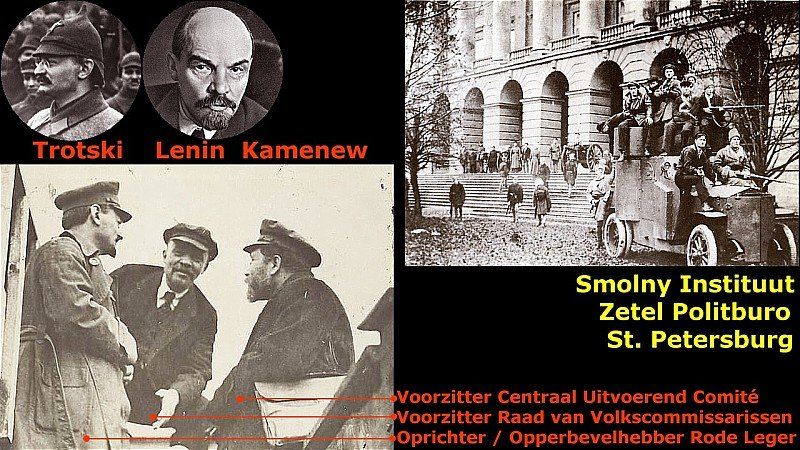Lenin's Treinreis
DUTCH Page - Pierre’s Column d.d. 7 november 2007

Vandaag, precies negentig jaar geleden, loste de Pantserkruiser Aurora in Sint Petersburg een aantal kanonschoten om het begin van de Russische Oktoberrevolutie aan te kondigen. De meesten onder ons kennen de geschiedenis al: Lenin’s “finest hour” was eindelijk aangebroken. Speelden de Bolsjewieken aanvankelijk nauwelijx een rol van betekenis, Lenin wist de opstandige soldaten- en matrozensovjets in te palmen voor zijn eigen bolsjewistische doel, kortweg alle macht aan de Sovjets (raden) en een afzonderlijke vrede met Duitsland. Daarmee stal Lenin het oorspronkelijke idee van zelfbestuur van de raden van de opstandige arbeiders, soldaten, en matrozen. Later vanaf 1920 zou Lenin deze raden en hun idealen geleidelijk vervangen door de dictatuur van de partij en het Politburo. De matrozen en soldaten, die Lenin aan de macht hadden geholpen, zouden in 1920 afgemaakt worden tijdens de zogenaamde bestorming over het ijs rondom de eilandvesting van Kronsjtad, op 30 kilometer van Sint Petersburg. De gevolgen van de Oktoberrevolutie zijn, ondanks de Val van de Berlijnse Muur in 1989, in de bedrijfscultuur van de hedendaagse Russische politiek nog altijd voelbaar, al was het maar in persoon van de almachtige Rode Tsaar, Vladimir Poetin zelf.
Wat minder bekend misschien is het feit, dat het succes van de Oktoberrevolutie van 1917 voor een belangrijk deel te danken is aan de intriges van Parvus Helphand en de toenmalige Duitse regering. De Krupp handelsagent, Alexander “Parvus” Helphand, die van west-Russische komaf was en die in 1916 de Pruisische nationaliteit had verkregen, haalde de Duitse minister van Buitenlandse Zaken, Arthur Zimmermann, over om een poging te wagen om in Rusland een massastaking te organiseren om de toch al bestaande destabilisatie van Rusland verder uit te buiten(*). Parvus wist uiteindelijk Zimmermann te overtuigen van het belang van de steun aan een Russische, revolutionaire beweging, die vrede met Duitsland wilde. Parvus had contacten met de leidende bolsjewistische revolutionairen, Trotski en Lenin, die op dat moment nog in ballingschap woonden; Trotski in New York, Lenin in Zwitserland. Zimmermann haalde op zijn beurt de Oberste Heeres Leitung over om de Bolsjewiek, Vladimir Iljitsj Oeljanov, Lenin dus, met Duitse hulp en geldmiddelen vanuit Zürich naar Rusland te smokkelen.
Op 9 april 1917 vertrekt Lenin met zijn vrouw, Kroepskaja, en 30 getrouwen uit Zürich in een “verzegelde” trein en onder een valse identiteit om via Zweden op 16 april aan te komen in Sint Petersburg. De 15 miljoen Duitse Reichsmarken, die Parvus Helphand had geregeld, gebruikt Lenin kwistig om zijn revolutionaire pamfletten te laten drukken en massaal onder de bevolking te laten verspreiden. In juli 1917 breekt opnieuw een kleine revolutie uit in Sint Petersburg door soldaten, die weigeren nog langer naar het front te gaan. Kerensky laat deze opstand hardhandig neerslaan. Lenin moet vluchten naar Finland en onderduiken. Op 20 oktober al keert Lenin samen met Trotski weer terug in Rusland. Op 25 oktober van de Juliaanse kalender, 7 november dus, voert Trotski, als directe legerleider, maar onder de regie van Lenin, de bolsjewistische troepen aan. De Bolsjewieken slagen erin om de Voorlopige Regering af te zetten. De volgende dag wordt Lenin gekozen tot voorzitter van de Pan Russische Conferentie van Sovjets en de Raad van Volkscommissarissen. Lenin benoemt Trotski tot Minister van Buitenlandse Zaken. Diezelfde dag nog neemt Trotsky contact op met Zimmermann om hem te verzoeken om onderhandelingen over een afzonderlijke vrede te openen. Lenin kondigt een eenzijdige wapenstilstand van 3 maanden af. De Russische slagkracht aan het Oostfront stelt dan niets meer voor. De Duitsers vertrouwen de revolutionairen niet helemaal. De strijd zal daarom pas echt gestaakt worden bij de Vrede van Brest Litovsk van 3 maart 1918.
Op 7 november denk ik dus terug aan deze vorm van Duitse “Realpolitik”. Lenin was voor de Duitsers dus een uiterst succesvol wapen geworden met onvermoede resultaten. Dankzij de ineenstorting van het Oostfront was de Oberste Heeres Leitung in staat om grote hoeveelheden troepen over te hevelen naar het hardnekkige Westelijke Front.
Met de opportunist Helphand, de initiator van Lenin’s treinreis, liep het nog slecht af. Parvus was vanaf 1918 niet meer welkom in Lenin’s Sovjet Unie, noch in de Weimar Republiek, waar kort daarvoor de Kaiser was afgezet. Parvus stierf kort daarna, in 1924, in Zwitserland in ballingschap.
Pierre
(*) In februari 1917 was er al eerder in Rusland een revolutie geweest, die geleid had tot de arrestatie van de Tsaar en de instelling van de Voorlopige Regering onder leiding van de liberale Prins Lvov en de socialistische Alexander Kerenski.
TIP
- Lees ook mijn lezing
voor de Western Front Association Nederland: " Bochkareva en haar Vrouwenbataljon
"










